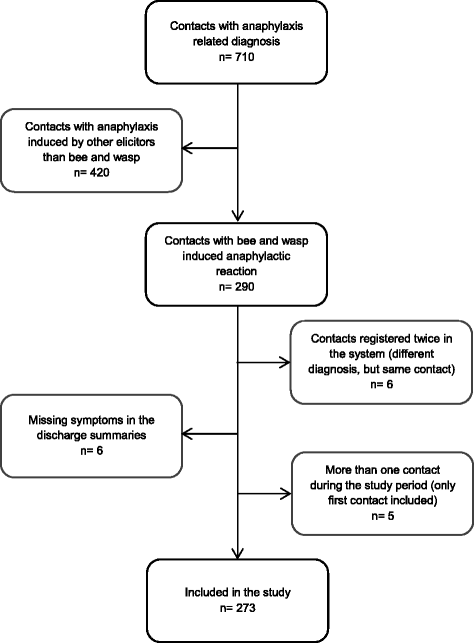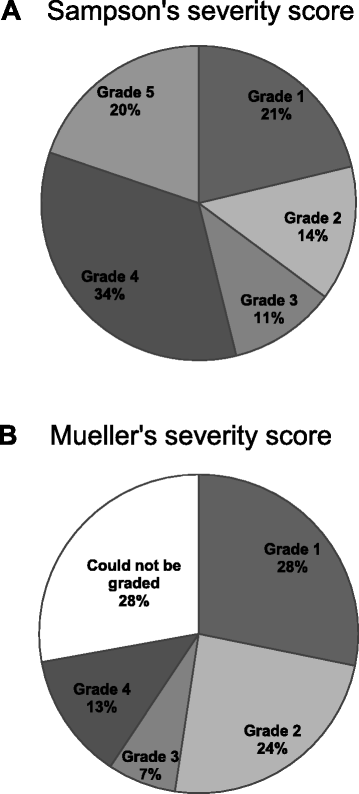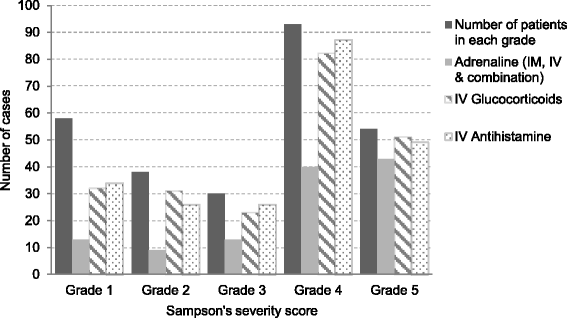Pre-hospital treatment of bee and wasp induced anaphylactic reactions: a retrospective study
- PMID: 28088250
- PMCID: PMC5237483
- DOI: 10.1186/s13049-016-0344-y
Pre-hospital treatment of bee and wasp induced anaphylactic reactions: a retrospective study
Abstract
Background: Bee and wasp stings are among the most common triggers of anaphylaxis in adults representing around 20% of fatal anaphylaxis from any cause. Data of pre-hospital treatment of bee and wasp induced anaphylactic reactions are sparse. This study aimed to estimate the incidence of bee and wasp induced anaphylactic reactions, the severity of the reactions and to correlate the pre-hospital treatment with the severity of the anaphylactic reaction.
Methods: Retrospective and descriptive study based on data from the Mobile Emergency Care Units (MECUs) in the Region of Southern Denmark (2008 only for Odense and 2009-2014 for the whole region). Discharge summaries with diagnosis related to anaphylaxis according to the International Classification of Diseases 10 (ICD-10) were reviewed to identify bee and wasp induced anaphylactic reactions. The severity of the anaphylactic reaction was assessed according to Sampson's severity score and Mueller's severity score. Treatment was evaluated in relation to administration of adrenaline, glucocorticoids and antihistamine.
Results: We identified 273 cases (Odense 2008 n = 14 and Region of Southern Denmark 2009-2014 n = 259) of bee and wasp induced anaphylaxis. The Incidence Rate was estimated to 35.8 cases per 1,000,000 person year (95% CI 25.9-48.2) in the Region of Southern Denmark during 2009-2014. According to Sampson's severity score, 65% (n = 177) of the cases were graded as moderate to severe anaphylaxis (grade 3-5). Almost one third of cases could not be graded according to Mueller's severity score. Adrenaline was administrated in 54% (96/177) of cases with moderate to severe anaphylaxis according to Sampson's severity score, compared to 88% receiving intravenous glucocorticoids (p < 0.001) and 91% receiving intravenous antihistamines (p < 0.001). Even in severe anaphylaxis (grade 5) adrenaline was administered in only 80% of the cases.
Conclusion: Treatment with adrenaline is not administered in accordance with international guidelines. However, making an assessment of the severity of the anaphylactic reaction is difficult in retrospective studies.
Keywords: Anaphylaxis; Pre-hospital treatment; Severity.
Figures



Similar articles
-
Anaphylaxis in an emergency care setting: a one year prospective study in children and adults.Scand J Trauma Resusc Emerg Med. 2017 Nov 22;25(1):111. doi: 10.1186/s13049-017-0402-0. Scand J Trauma Resusc Emerg Med. 2017. PMID: 29166906 Free PMC article.
-
Hymenoptera stings.Clin Tech Small Anim Pract. 2006 Nov;21(4):194-204. doi: 10.1053/j.ctsap.2006.10.002. Clin Tech Small Anim Pract. 2006. PMID: 17265905 Review.
-
Climate data, localisation of the sting, grade of anaphylaxis and therapy of hymenoptera stings.Swiss Med Wkly. 2016 Feb 9;146:w14272. doi: 10.4414/smw.2016.14272. eCollection 2016. Swiss Med Wkly. 2016. PMID: 26859128
-
Route of administration of adrenaline for the treatment of anaphylactic reactions to bee or wasp stings.Clin Exp Allergy. 1991 Nov;21(6):753-6. doi: 10.1111/j.1365-2222.1991.tb03208.x. Clin Exp Allergy. 1991. PMID: 1777837 No abstract available.
-
[Hymenoptera stings].Przegl Lek. 2007;64(4-5):282-9. Przegl Lek. 2007. PMID: 17724887 Review. Polish.
Cited by
-
Anaphylaxis in an emergency care setting: a one year prospective study in children and adults.Scand J Trauma Resusc Emerg Med. 2017 Nov 22;25(1):111. doi: 10.1186/s13049-017-0402-0. Scand J Trauma Resusc Emerg Med. 2017. PMID: 29166906 Free PMC article.
-
Analysis of Hymenoptera venom allergy in own material. Clinical evaluation of reactions following stings, in patients qualified for venom immunotherapy.Postepy Dermatol Alergol. 2019 Jun;36(3):302-307. doi: 10.5114/ada.2018.75607. Epub 2018 May 22. Postepy Dermatol Alergol. 2019. PMID: 31333347 Free PMC article.
-
An Envenoming Syndrome from Massive Vespa Stings Induces Multiple Organ Failure.Insects. 2020 Apr 2;11(4):219. doi: 10.3390/insects11040219. Insects. 2020. PMID: 32252275 Free PMC article.
-
Anaphylaxis: first clinical presentation, subsequent referral practise, and suspected elicitor-an observational study.Intern Emerg Med. 2024 Oct;19(7):2047-2056. doi: 10.1007/s11739-024-03589-5. Epub 2024 Apr 10. Intern Emerg Med. 2024. PMID: 38598086 Free PMC article.
References
-
- Johansson SG, Bieber T, Dahl R, Friedmann PS, Lanier BQ, Lockey RF, et al. Revised nomenclature for allergy for global use: report of the nomenclature review committee of the world allergy organization, October 2003. J Allergy Clin Immunol. 2004;113(5):832–6. - PubMed
MeSH terms
Substances
LinkOut - more resources
Full Text Sources
Other Literature Sources
Medical

